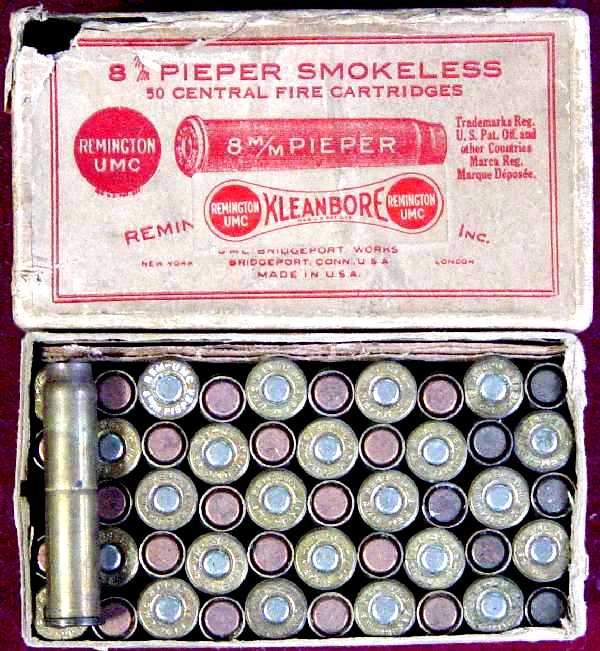|
THE CARTRIDGE COLLECTOR'S EXCHANGE |
| Contents
Cartridge
Lists
Prior Picture Pages:
Links to Other Sites
Cartridge Collectors Organizations:
Auctions:
Books:
Other Collector's Sites:
|
Home of the Old Ammo Guy's Virtual
Cartridge Trading Table
Picture Page October 2008 An unusual box of Remington-UMC cartridges..... Here's a box of Remington made cartridges that seems a little out of place in this country, and appropriately so, as the Pieper revolvers and carbines that they were made for saw limited use in Mexico and did not make it to this country in adequate numbers to be recognizable to the general gun and cartridge collecting crowd. The Peiper firearms were made by H. Pieper in Belgium, and those adopted by Mexico were designated the Model 1893. The Union Metallic Cartridge Company produced this cartridge as early as 1901, and included it in their catalog. Remington-UMC included it in their catalog from 1911 until at least 1914, but no longer listed it after 1916. The box shown above is of the style used by Remington-UMC from about 1916 to 1921, based on the address shown on the label. This would indicate that at least one batch of this ammunition was produced during the period (1916 - 1921) that this box style was in use, but most likely following the conclusion of World War 1. However, note that a small dogbone Kleanbore label has been added, which would indicate that this particular box of ammunition was loaded in 1926 or later, as 1926 was the year Kleanbore priming was introduced.
Much of the information regarding the makers, headstamps, and production dates of this ammunition was obtained from a discussion of the 8mm Pieper cartridge on the IAA cartridge forum, which can be found at the following address: http://cartridgecollectors.org/forum/viewtopic.php?t=4467&postdays=0&postorder=asc&start=0 . . .
What a difference a name makes........
When checking out the offerings on those overcrowded gun show tables, don't be too quick to dismiss the often encountered powder and shot measures. There must have been lots of these things sold, because they seem to show up more often than any of the other vintage reloading tools. Consequently, they don't tend to sell for too much, in spite of some being of very high quality and in little used condition. These generally tend to be marked, 99% of which will be found to have been made by the Bridgeport Gun Implement Company, and marked either B.G.I.CO. or Bridgeport G. I. CO. Other markings on the Bridgeport items will include either a patent date or product number. Its the remaining 1% that should be watched for, as they will occasionally be found marked with the name the classic shotgun maker Parker Brothers. While the Parker Brothers examples are usually quite plain, they are highly sought after and generally sell for many times more than the B.G.I.CO. marked examples, even though the Parker marked ones were probably produced by B.G.I. The markings on these four measures are shown below. The elusive Parker Brothers example is the one on the right. The first three are marked as being made by the Bridgeport Gun Implement Company. The first and second are marked B.G.I.CO. with the patent dates November 23rd, 1886 and February 25th, 1890, respectively. The third one with the rosewood handle is marked Bridgeport G. I. CO. No 21 (the product or catalog number). Sometimes, the Parkers Brothers examples will also have a product number included in the marking.
. . . . .
A couple of 'links' to the past.....
Shown here are a couple of machine gun links and a .30-06 cartridge that I picked up in a box of assorted cartridge related odds and ends at our last local gun show. Written on one side of the tag that is attached is 'machine gun cartridge and section of belt', and on the other side 'army maneuvers Concord N.H. 1936'. According to an article in the February 10, 1936 issue of Time Magazine, these were winter maneuvers conducted by the Army Air Force in February of 1936. 'Using Mitchell Field, N. Y., Concord, N. H. and Burlington, Vt. as bases, 62 pursuit, attack and bombing planes carrying 216 men, began chasing back & forth over snowy hills to test equipment and find out, among other things, if machine-gun oil will lubricate at sub-zero temperatures.' A February 2, 1936 article in the New York Times regarding the maneuvers indicated that the purpose was to test motors and guns in freezing temperatures. 'Disintegrating' machine gun belts made up of individual metal links first came into use in World War 1. The unusual (based on the black or dark blue examples typically found today) silver color of those above is the result of a tin finish intended to prevent the steel from rusting that was standard for these links in the 1920s and 1930s. . . .
|

